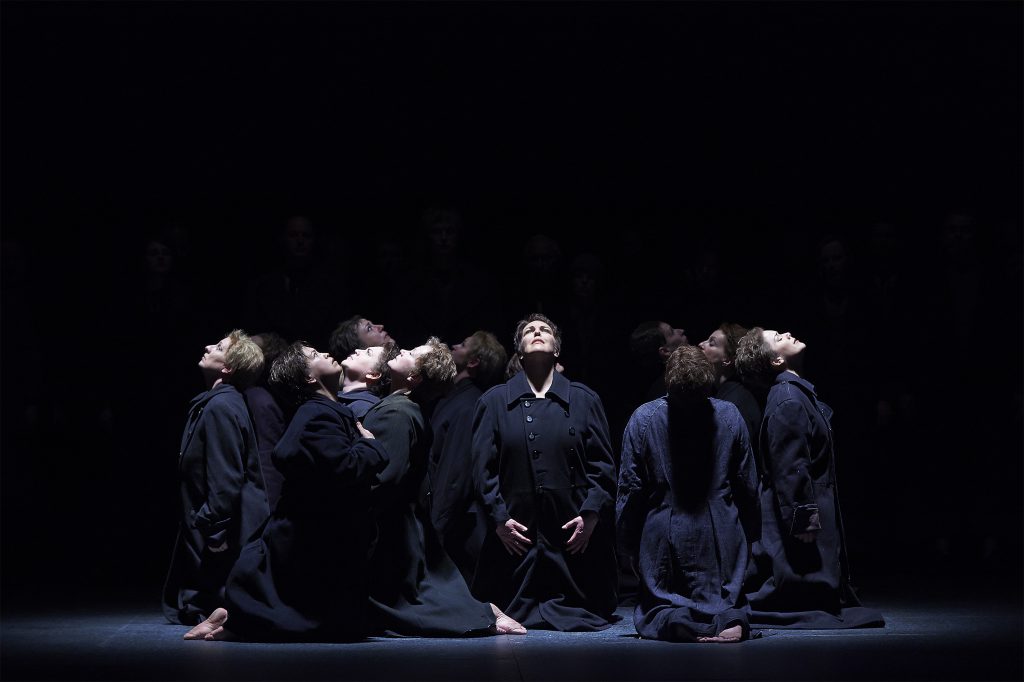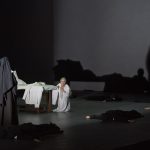He was a musical enfant terrible, “part monk, part delinquent”, one acquaintance recalled. At eighteen, he met and was befriended by Guillaume Apollinaire. The precocious adolescent promptly produced a cycle of dramatic mélodies based on thirty of the poet’s early short works. Igor Stravinsky lobbied to have the songs published. Encouraged by Jean Cocteau, the brilliant young modernist and a small group of like-minded conspirators founded Les Six, a loosely organized collective of rabble-rousers dedicated to redefining music much as Cubists and Surrealists had redefined the visual arts. Unpredictable, fiercely intelligent, irreverent, Francis Poulenc was on a fast track to fame and fortune. Serge Diaghilev commissioned him to write an original score for the Ballet Russe. Then, shockingly, four of his closest, most cherished friends died without warning. Desperately seeking to make sense of the devastating events, Poulenc travelled to the pilgrimage town of Rocamadour in southwestern France. There, gazing at the image of the Black Madonna, he experienced a sudden, inexplicable outpouring of intense spirituality. For the rest of his life, Francis Poulenc, one-time rebel, hipster, artistic thrill-seeker, would devote much of his restless talent to expressions of Christian faith and devotion. Dialogues des Carmélites was to be his most eloquent work.
The Canadian Opera Company’s final offering in its 2012-13 season revoices Poulenc’s stunning composition with acute clarity. There is a terrible beauty to Robert Carsen’s production, a gripping, sharp-angled spareness to his staging of this, arguably the most excruciating of all twentieth century operas. Joined by Michael Levine, director and designer fill the expansive Four Seasons Centre stage with a series of haunting tableaux, one scene streaming seamlessly into the next like a river of troubled dreams. Gone is any notion of set or decoration. Flat towering slabs, walls of gray nothingness, define the action witnessed by stark panoramic rows of performers. This is a production of sweeping dimensions, visually, musically, emotionally.
Based on an actual historical event that occurred in 1794, Poulenc’s taut, episodic three-act opera leaps time and space, hurtling forward into uncertainty.
Act 1. Paris. House of the Marquis de la Force.
- As the French Revolution gathers violent momentum, a distressed young noblewoman, Blanche de la Force, announces to her anxious brother and father that she intends to become a Carmelite nun. The sanctity of the convent is her last best hope for a life of security and inner peace.
Carmelite convent.
- Blanche is interviewed by the aged Prioress who reminds her that it is not their order who will protect her but she who must protect the order through the power of her prayers.
- Sister Blanche is frightened by Sister Constance, another recently accepted Carmelite novitiate, when, during the course of their chores, Constance reveals that she has had a dream that the two of them will die together one day.
- The Prioress is gravely ill, tormented and wracked with pain. Sister Blanche, a favourite since first they met, is summoned for a last farewell. Mother Marie urges the Prioress to devote her dwindling energy to God’s service. Seized by a visionary fit, the Prioress rages at God’s abandonment of her and the sisters. As Blanche looks on in horror, the Prioress collapses and dies.
Act 2. Carmelite convent.
- Overcome with grief, Sister Blanche finds herself unable to continue her solitary vigil at the Prioress’s graveside. Mother Marie forgives her. They will not speak of Blanche’s failure. The shame is punishment enough.
- Blanche and Sister Constance prepare a garland for the Reverend Mother. Constance thinks her passing was too difficult, almost as if she had been handed the wrong coat in a cloakroom.
- The Reign of Terror rages beyond the convent walls. A new Prioress is chosen, an outsider, Madame Livoine. “Prayer is a duty, martyrdom is a reward,” she announces prophetically.
- Blanche’s brother, the Chevalier de la Force, arrives to persuade her to join him abroad. They argue. Blanche will share her sisters’ fate come what may, she insists.
- The convent’s Father Confessor holds mass. It will be his last. He must go into hiding. The Revolutionary Council has declared all priests enemies of the Republic.
- A mob bursts through the chapel door. The nuns are to leave the convent at once. Their property has been seized.
Act 3. Carmelite Convent.
- The convent has been ransacked. The nuns have assembled. Mother Marie proposes they hold a vote — abandon the convent or stay and risk their lives. There is only one dissenting ballot. Constance claims it was hers. Blanche slips away unnoticed.
- Mother Marie discovers Blanche disguised as a servant in the ruins of her father’s house. The Marquis has been executed. Blanche is terrified. Mother Marie pleads with her to return to the arms of the sisterhood. En route to a safe house, Blanche learns all have been imprisoned.
- Sentence is pronounced on the Carmelites. The People’s Tribunal has condemned them to death as traitors to the revolutionary cause.
- One by one, the nuns are guillotined. Sister Blanche appears. Fearless, wrapped in a newfound serenity, Blanche joins her sisters in martyrdom as the blade slashes downwards, frozen in a flash of pure transcendent grace.
With its carefully developed story arc and progression of discrete character-driven scenes, Dialogues des Carmélites has a pronounced cinematic quality. The movie resemblance is no coincidence. Originating as a novella entitled, The Last on the Scaffold, by German author Gertrude von Le Fort, the story was reshaped into a screenplay by film writer Georges Bernanos in 1947. When Poulenc finally read the unproduced final draft in 1953, he saw an almost ready-made libretto complete with dialogue. Even the inspiration for a title. Actually turning film noir thriller into Dialogues des Carmélites, the opera, was another story. The project took its toll on Poulenc’s nerves. It would take the composer another three years to mold the Bernanos script into a work of enduring artistic genius.
Poulenc’s opera is multi-layered. More than a little relevant political subtext underpins his adapted scenario. In director Robert Carsen’s COC production, a 105-member mob acts as an anonymous vengeance machine sweeping up hapless protagonists, engulfing them, crushing all hope of escape, then sweeping them off stage again back into the darkness. As a physical expression of tyranny, Carsen’s gang of street thugs could not be more palpable. But the director is well aware that Dialogues des Carmélites, however compelling its metaphors — and many have been detected — is much more than a study in mass psychology. And much bigger than simply a tragic tale about an innocent band of murdered nuns.
It is, quite simply, a story about the need to overcome fear and the challenge of acting with moral correctness. It is terrifying. It is inspirational. And profoundly human.
Musically, Dialogues des Carmélites is as accessible as it is theatrical. The work, premiered at La Scala in 1957, is rooted more in the nineteenth century than the twentieth. Poulenc was not at all attracted to contemporary avant-garde trailblazers like atonalist Alban Berg. His acknowledged heroes were classicists — Verdi and Mussorgsky. Not so much old-fashioned, more popular song-influenced, Poulenc’s ariosos have a natural inflection to their tone even beyond what might be expected of the form. The music hall was Poulenc’s native habitat. The recital hall was not for him.
Singing the role of Dialogues des Carmélites’ Sister Blanche, Toronto-based Isabel Bayrakdarian grows her character from innocence to insight with affecting credibility. It is a long demanding journey. Bayrakdarian’s bright, cloudless soprano, slightly undervoiced in her initial onstage appearances, quickly gathers strength becoming more forceful yet paradoxically angelic as Blanche’s life experiences unfold. It is a masterful rendering, subtle, sensitive and spellbinding.
As First Prioress, mezzo-soprano Judith Forst delivers the performance of a lifetime. Hers is a Mother Superior of towering dignity, a woman of great compassion, all but worn out by a life of duty and sacrifice. Forst tints her naturally warm, all- embracing instrument, with shades of heart-breaking weariness rising to a chilling scream as death strikes the prioress down. The depth of anguish and suffering is beyond description. Forst’s humanity is overwhelming, her artistry astonishing.
Adrienne Pieczonka, appearing as the steely Second Prioress, and Irina Mishura as forgiving Mother Marie, reach deep into their counterpointed characters to produce performances of superb intensity, both voices finely pitched and radiant.
French-Canadian tenor Frédéric Antoun, with his clear, lustrous timbre, brings a marvelous luminosity to his onstage turns as the Chevalier de la Force. Hélène Guilmette is a touchingly spontaneous Sister Constance.
Music director Johannes Debus conducts the supremely versatile COC orchestra with his characteristic blend of energy and intuition. Poulenc’s quasi jazz rhythms are particularly well revealed. Long deliberate scenic segues of utter silence are timed to agonizing perfection, musical non-music, breathlessly suspenseful.
Dialogues des Carmélites is one of only a handful of twentieth century operas to have remained more or less in permanent rotation since first performed. The Robert Carsen presentation, imported from Nederlandse Opera, has its own unique durability. High impact staging and soaring performances make this production impossible to forget. The Canadian Opera Company’s visionary Dialogues des Carmélites will play forever in the mind.








